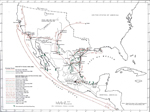|

 Explorers, Scientists &
Inventors
Explorers, Scientists &
Inventors
 Musicians, Painters &
Artists
Musicians, Painters &
Artists
 Poets, Writers &
Philosophers
Poets, Writers &
Philosophers
 Native Americans & The Wild
West
Native Americans & The Wild
West
 First Ladies
First Ladies
 Popes
Popes
 Troublemakers
Troublemakers
 Historians
Historians
 Archaeologists
Archaeologists
 Royal Families
Royal Families
 Tribes & Peoples
Tribes & Peoples

Assassinations in History
Who
got slain, almost slain, when, how,
why, and by whom?
 Go to the
Assassination Archive
Go to the
Assassination Archive




Online History Dictionary A - Z
All-Time Records in
History
What was the
bloodiest battle, the battle with the least
casualties, who was the greatest military leader?
 Go to
Records in History
Go to
Records in History

|
|
Texas Revolution 1835-1836
The Texas Revolution, also called Texan Revolution, Texas
Revolt, or
War of Texan Independence, started on October 2, 1835, and
ended April 21, 1836.
|
|
Who Fought the Texas Revolution
Texians (Anglo-American settlers in Texas, many from the United States)
and
Tejanos (Texan natives of Mexican descent)
vs.
the Mexican government,
led by President
 Antonio López de Santa Anna
Antonio López de Santa Anna
Why Was the Texas Revolution Fought?
Despite cultural clashes, Texians and Tejanos were united by their desire for greater autonomy and resistance against
a government they perceived as oppressive.
Issues like immigration restrictions and the abolition of slavery, which affected both populations differently, were
hot button issues.
This alliance was strategic: Tejanos hoped to protect their land and rights while Texians sought independence from
Mexico.
|
The Texas Revolution in a Nutshell
The Texas Revolution (1835-36) was sparked by cultural and political tensions between Mexico and American
settlers in Texas, then part of Mexican territory.
Mexico's shift toward centralization under President Santa Anna conflicted with settlers' desires for
autonomy and continued immigration.
Fighting began October 1835 at Gonzales. Texian victories in late 1835 included capturing San Antonio and
declaring a provisional government.
However, Santa Anna's counteroffensive in early 1836 initially succeeded, taking the Alamo (March 6) and
executing surrendered forces at Goliad (March 27).
The tide turned at the Battle of San Jacinto (April 21, 1836), where Sam Houston's army surprised and defeated
Santa Anna, capturing him.
The Treaties of Velasco secured Mexican withdrawal and Texas independence, though Mexico never formally
recognized it.
Key outcomes:
The Texas Revolution
- created the independent Republic of Texas (1836-1845)
- established the Texas-Mexico border at the Rio Grande
- set stage for U.S. annexation of Texas (1845)
- contributed to the Mexican-American War (1846-48)
Background to the Texas Revolution
The reasons why the Texas Revolution was fought in a little bit more detail:
:: Political Centralization ::
The Mexican government under President Antonio López de Santa Anna aimed to concentrate all power in the hands of the
president and the central government, which curtailed the rights and autonomy of its citizens in Texas.
This led to dissatisfaction among settlers who were accustomed to a degree of self-governance.
By the way, all in all, Antonio López de Santa Anna served as President of Mexico intermittently from 1833 to 1855.
He held the presidency eleven times, with terms varying in length, sometimes lasting only a few weeks and other times
extending for a couple of years. His last term, from 1853 to 1855, was marked by attempts to establish a dictatorship,
which goes to show that the Texans had a point.
Santa Anna was ultimately overthrown and went into permanent exile in 1855.
:: Cultural Clashes ::
The Anglo settlers often refused to adopt the Spanish language or integrate into Mexican society, leading to mistrust
and conflict between them and the Mexican authorities.
:: Slavery ::
The abolition of slavery in Mexico in 1829 created tension, as many Anglo settlers in Texas wanted to maintain the
institution of slavery for economic reasons, particularly for cotton farming.
The fertile lands along the Brazos, Colorado, and Trinity River valleys in Texas became central to cotton farming, driven largely
by Anglo settlers.
In 1829, Cotton farming in Texas was still in its early stages. However, by 1835, Texan cotton exports reached
approximately 3.15 million pounds* worth an estimated $500,000, or approximately $17 million to $18 million
in today's money.
* = weight of the cotton itself, not British pounds as a currency
:: Immigration Restrictions ::
The Mexican government attempted to limit further immigration from the United States through laws such as the Laws of April 6, 1830,
which restricted settlement and increased taxes on goods imported from the U.S.
This incited great resentment among settlers who felt their rights were being violated.
Build-Up to the Texas Revolution
:: Fredonian Rebellion 1826 ::
The Fredonian Rebellion was a brief and unsuccessful uprising that took place from December 21, 1826, to January 31, 1827, led
by empresario * Haden Edwards and a small group of Texian settlers near Nacogdoches, Texas.
* = An empresario was a land agent or contractor in early 19th-century Texas. The Mexican government granted him the authority
to recruit settlers to settle in Texas. Empresarios also had to ensure that settlers complied with Mexican laws, including
converting to Catholicism and learning Spanish.
These were Mexico's efforts to populate and develop Texas following its independence from Spain.
One notable empresario was Stephen F. Austin, who is often regarded as the most successful, having organized the first larger
group of settlers known as the "Old Three Hundred."
The rebellion was sparked by Edwards's heavy-handed tactics regarding land titles, which alienated established settlers and led to the
revocation of his empresario contract by the Mexican government.
In response, Edwards and approximately 30 followers seized the Old Stone Fort and declared independence, forming the Republic of
Fredonia*.
* = The term "Fredonia" was proposed by Dr. Samuel Latham Mitchill in the early 1800s as a name for the United States,
combining the English word "freedom" with a Latin ending to signify a "place of freedom."
Although it was intended to serve as a national name, it ultimately did not gain widespread acceptance but inspired the name
of various towns, including the village of Fredonia in New York. The term reflects early American aspirations for identity and
independence.
They sought support from local Native American tribes, notably the Cherokee, but failed to gain significant assistance.
As Mexican military forces approached, the rebels abandoned their cause and fled eastward. Despite its failure, the rebellion alarmed
the Mexican government and contributed to increasing tensions between Anglo settlers and Mexican authorities.
:: Mier y Terán Report 1828 ::
The Mier y Terán Report was compiled by General Manuel de Mier y Terán in 1828. It had been commissioned by the Mexican government
to assess the situation in Texas amid growing concerns about American immigration and influence.
Following the Fredonian Rebellion in late 1826 (see above), the Mexican government recognized the need to understand the dynamics
in Texas better. Mier y Terán was sent to investigate the conditions and sentiments of the settlers.
Mier y Terán reported that:
-
Anglo-American settlers vastly outnumbered Mexican residents in Texas, with a ratio of approximately 10 to 1, which alarms
about potential rebellion against Mexican rule.
-
Many Anglo settlers refused to learn Spanish and maintained separate schools and trade practices, primarily with the United
States.
-
Mexican influence in Texas was minimal, with weak civil governance and little enforcement of laws, leading to a sense of
lawlessness among settlers.
Mier y Terán recommended to:
- Establish more military posts in Texas to assert control
- Encourage immigration from Mexico and Europe to increase the Mexican population in Texas
- Strengthen trade ties between Texas and Mexico
- Implement stricter enforcement of laws, including prohibitions on slavery
Mier y Terán's report resulted in the Law of April 6, 1830.
:: Law of April 6, 1830 ::
The Law of April 6, 1830, or Ley del 6 de abril de 1830 in Spanish, was enacted by the Mexican government
to restrict American immigration into Texas and tighten control over the region following concerns raised by the
Mier y Terán Report.
It aimed to curb the influx of Anglo settlers, prohibit the introduction of new slaves, and bring settlement
contracts under federal control.
:: Bradburn's arrests in May 1832 ::
The Law of April 6, 1830 included provisions for customs duties on goods entering Texas from the United States. To this end,
Mexican authorities established military posts and customs houses in Texas, including at Velasco and Anahuac.
Meet Colonel Bradburn, the commander at Fort Anahuac.
Colonel Juan Davis Bradburn was born John Davis Bradburn in Richmond, Virginia. He participated in the Gutiérrez-Magee Expedition
against Spanish rule and served in the Louisiana militia during the War of 1812. After Mexico gained independence from Spain, he
became a Mexican citizen and was aiming for unique career opportunities in the newly formed Mexican Army.
Somehow he became a courier for Emperor Agustín de Iturbide, and His Excellency himself arranged for Bradburn to marry into
a prominent Mexican family.
He had a reputation of
being harsh, authoritarian, and oppressive, and it would be fair to conclude that Colonel Juan Davis Bradburn had a considerable chip on his shoulder.
As the commander at Fort Anahuac. Bradburn's strict enforcement of Mexico's new customs regulations
included demanding that all ships entering Galveston Bay first dock at Anahuac for inspection, which did not sit right with the
those who were concerned.
Then, in May 1832, he unjustly arrested local
lawyer William Barret Travis on charges of attempted insurrection.
Travis's business partner, Patrick Jack, was also arrested after he threatened Bradburn in response to Travis's detention.
So, a Texian did arrest another Texian, but in the name of the Mexican government and without due process.
Plus, Bradburn had the two men placed in a large brick kiln as their holding cell.
Bradburn's actions were seen as
overreaching and sparked outrage among the Texian settlers.
Colonel Juan Davis Bradburn was officially relieved of his duties and removed from his post on June 29, 1832, after which
he fled to New Orleans. And William Barret Travis and Patrick Jack were released from prison on July 1, 1832.
But it took the Battle of Velasco...
:: Battle of Velasco 1832 ::
The Battle of Velasco, fought from June 25 to June 26, 1832, was the first proper military engagement in the lead-up
to the Texas Revolution.
In response to Colonel Bradburn's outrageous behavior (see above), Texian leaders, including John Austin, organized a
militia to transport a cannon down the Brazos River for potential use against Mexican forces at Fort Anahuac, and
to put pressure on Bradburn to release the two unjustly arrested men.
On June 22, Austin and approximately 112 Texians began their march towards Fort Velasco.
They planned a coordinated attack involving both land and naval forces. The Texians launched their assault shortly
before midnight on June 25, surrounding the fort and engaging in heavy fighting. The battle involved sharpshooting
and artillery exchanges, with both sides suffering casualties.
The Texians sustained about seven killed and 14 wounded, while Mexican forces, commanded by Colonel Domingo de
Ugartechea, reported five killed and 16 wounded. As the battle progressed, Mexican ammunition ran low, leading Ugartechea
to surrender on June 26 after realizing he would not receive reinforcements.
The terms of surrender allowed Ugartechea and his men to leave with their arms and provisions, marking a historical
victory for the Texians.
The battle is often referred to as the "Boston Harbor of Texas" due to its symbolic importance in asserting Texian
resistance against Mexican authority.
:: Battle of Nacogdoches 1832 ::
The Battle of Nacogdoches, which took place on August 2, 1832, was rooted in the tensions following the Anahuac Disturbances
and the broader conflict between Texian settlers and Mexican authorities.
Colonel José de las Piedras, the Mexican commander in Nacogdoches, had issued an order requiring residents to surrender their
arms, which not only provoked resistance among the local population, but also a response from local leaders, including
James Bowie, who rallied support from surrounding settlements.
By late July 1832, a force of around 300 Texians had gathered in Nacogdoches.
On the morning of August 2, Bowie and the Texian militia marched into Nacogdoches to confront Piedras. When negotiations failed,
a skirmish broke out as a group of about 100 Mexican cavalry attacked the Texians.
The Texians returned fire and engaged in house-to-house fighting, eventually taking control of several buildings, including
the Old Stone Fort.
As casualties mounted for the Mexican forces — approximately 47 killed and over 40 wounded — the Mexican army
retreated. During the night, they evacuated from Nacogdoches entirely.
The following day, Bowie and his men ambushed the fleeing Mexican troops along the Angelina River. Colonel Piedras was captured
along with about 300 soldiers, a significant victory for the Texians.
The Texians suffered three killed and four wounded during the battle, with one additional Texian dying later from wounds
sustained in combat.
The Battles of the Texas Revolution
Battle of Gonzales
October 2, 1835
Texians refused to surrender a small cannon loaned by the Mexican government for defense against
Native Americans. When Mexican troops, numbering around 100, led by Lieutenant Francisco de Castañeda,
attempted to
retrieve it, Texian forces, numbering around 180, attacked and fired the cannon, signaling the start
of open rebellion. The Mexican forces retreated with minimal casualties.
Battle of Goliad
October 9, 1835
Surprise attack by Texian forces led by George Collingsworth against a small Mexican
garrison at Fort Presidio La Bahía. The Texians captured the fort without much
resistance.
Siege of San Antonio de Béxar
October 12 - December 9, 1835
Texian volunteers besieged Mexican General Martín Perfecto de Cos and his troops in San Antonio.
The siege culminated in intense urban combat, particularly from December 5-9, leading to the
Texians' victory and the surrender of General de Cos.
Battle of Concepción
October 28, 1835
Texian forces, led by James Bowie, defeated Mexican troops commanded by Colonel Domingo Ugartechea
near Mission Concepción. The Texians, numbering about 90, effectively utilized their defensive
position to repel a larger Mexican force (around 275), resulting in minimal Texian casualties and major
Mexican losses.
 Defense
of the Alamo
Defense
of the Alamo
February 23 - March 6, 1836
Battle of San Patricio
February 27, 1836
Early morning Mexican surprise attack on Texian soldiers who were camped in San Patricio.
The engagement lasted about fifteen minutes. Out of approximately 34 Texians present,
eight were killed, and thirteen were taken prisoner. Reports indicate that many of the
captured Texians were executed shortly after.
Battle of Aqua Dulce
March 2, 1836
Mexican victory. General José Urrea's forces surprised and defeated Dr. James Grant's company of Texian
colonists and American volunteers, resulting in most of Grant's men being killed or captured, with Grant
himself among the dead.
Battle of Refugio
March 12-15, 1836
Texian forces under Colonel James W. Fannin sent a detachment to help evacuate settlers from Refugio Mission,
but this led to a series of clashes with Mexican forces under General Urrea, ultimately resulting in the
capture and execution of most Texian troops, while this delay also contributed to Fannin's later surrender
at Coleto Creek.
Battle of Coleto (Battle of Coleto Creek)
March 19-20, 1836
The Mexican Army, led by General José de Urrea, intercepted, surrounded, and the next morning, captured Texian Colonel James Fannin
and approx. 400-445 troops on their retreat from Goliad to Victoria, Texas.
Goliad Massacre
March 27, 1836
The execution of approx. 400 Texian prisoners-of-war (see Battle of Coleto) by Mexican troops, which galvanized Texian resolve.
Harrisburg Capture
April 18, 1836
Texian scouts captured a Mexican courier carrying crucial intelligence
about Santa Anna's army. This information revealed the size and plans of the Mexican forces and
was pivotal for Houston's subsequent victory at the Battle of San Jacinto, which
effectively ended the Texas Revolution.
 Battle of San Jacinto
Battle of San Jacinto
April 21, 1836. General
 Sam Houston and 800 men defeat
General
Sam Houston and 800 men defeat
General
 Antonio López de Santa Anna and his Mexican army of
1,500 men.
Antonio López de Santa Anna and his Mexican army of
1,500 men.
And here is the map of the major military movements February to April, 1836

Texas
Revolution - Movements Feb-Apr1836
Click map
to enlarge
This is a map of the campaign routes

TEXAS REVOLUTION
Click map to enlarge
The Outcome of the Texas Revolution
Texas became an independent republic for ten years, from 1836 - 1846, and then joined the United States.
In more detail:
After gaining independence from Mexico in 1836, Texans expressed a desire to join the U.S.
In September 1836, voters overwhelmingly supported annexation with a vote of 3,277 to 91.
However, the annexation process faced delays due to concerns about slavery and potential war with Mexico.
It wasn't until 1845 that the issue was revisited. On October 13, 1845, Texans voted again on the annexation proposal,
resulting in a decisive outcome of 4,245 in favor to 267 against.
Following this plebiscite, the U.S. Congress approved the annexation on December 29, 1845, formally recognizing
Texas as the 28th state of the Union.
The following is quoted from the
Atlas of Texas
Climaxing a series of political and
cultural clashes, the Anglo-Texan colonists refused to surrender a
cannon to Mexican troops at Gonzales, October 2, 1835, and open
warfare began. A week after their Gonzales victory, the Texans took
Goliad. Texan forces, under Stephen F. Austin then encamped near San
Antonio, engaging the Mexicans in battle on October 28 (Concepcion)
and November 26 (the Grass Fight). The Texans laid siege to San
Antonio December 5 and forced a Mexican surrender December 9.
After retreating from Texas, Santa
Anna's Mexican army began preparations to retake the territory.
Arriving back in San Antonio February 23, 1836, Santa Anna's forces
besieged the Texans in the Alamo until its fall, March 6, when all
remaining defenders were killed or captured.
In mid-February another Mexican army
under Urrea marched north from Matamoros, meeting and defeating
Texan forces at San Patricio (February 27) and Agua Dulce (March 2).
Urrea next overpowered James Fannin's Texan contingent near Goliad,
March 19, and - under orders from Santa Anna - executed 342 Texan
prisoners.
Determined to destroy the remaining
Texan forces, Santa Anna led his army east from San Antonio on March
21, following Sam Houston's retreating troops. By April 20 both
armies had reached San Jacinto, and on the following afternoon the
Texans routed the Mexican Army. The next day Santa Anna was
captured. Shortly thereafter, the remaining Mexican forces began
retreating toward Matamoros.
Sources:
Eugene C. Barker, "San Jacinto Campaign," Quarterly of the Texas
State Historical Association, Volume 4, 1901; Andrew Jackson
Houston, Texas Independence, Anson Jones Press, Houston,
1938; Amelia Williams, "A Critical Study of the Siege of the Alamo
and of the Personnel of Its Defenders," Southwestern Historical
Quarterly, Volume 37, 1933-1934.
Atlas of Texas, Copyright 1976
Board of Regents, The University of Texas System. Used by permission
of the University of Texas Libraries, The University of Texas at
Austin.
Go here for the
 Mexican-American War 1846-1848
Mexican-American War 1846-1848
And maybe
 American Timeline
American Timeline
More History
|